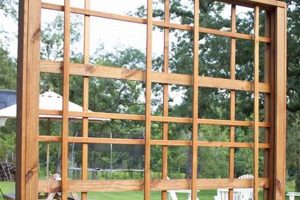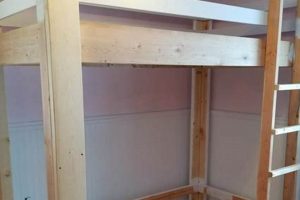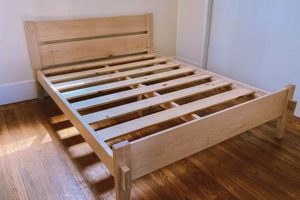A structure designed and constructed by an individual to provide support and load distribution for a backpack represents an alternative to commercially manufactured frames. This type of self-made support system often utilizes materials like wood, metal, or durable plastics, shaped and assembled to conform to the wearer’s back and transfer the weight of the pack’s contents to the hips and legs. For example, a hiker might construct a frame from lightweight aluminum tubing joined with rivets to carry camping equipment more comfortably.
The construction of a personalized support system offers several advantages. Primarily, it allows for customization to the specific dimensions of the users torso, promoting better weight distribution and reducing strain. The practice also represents a cost-effective solution compared to purchasing ready-made frames, particularly appealing to budget-conscious individuals. Historically, homemade rucksacks and carriers have been essential for explorers, pioneers, and those in resource-constrained environments, adapting readily available materials to meet their carrying needs. This resourcefulness has influenced modern approaches to adapting gear for specialized needs.
The following sections will detail the materials, tools, and techniques involved in constructing a durable and functional load-bearing structure for a backpack. Considerations for design, weight distribution, and attachment methods will also be explored to ensure a safe and effective outcome.
Essential Considerations for Self-Made Backpack Supports
The following guidelines aim to facilitate the construction of a safe, functional, and durable load-bearing structure for backpacks. Adherence to these points can improve the efficacy and longevity of a homemade frame.
Tip 1: Material Selection: The choice of materials should prioritize both strength and weight. Aluminum offers a favorable strength-to-weight ratio, while wood, though heavier, provides a degree of flexibility and can be more readily available. Regardless of the material, ensure it is suitable for outdoor use and resistant to environmental degradation.
Tip 2: Ergonomic Design: Prioritize a design that conforms to the natural curvature of the spine. Consider adjustable features to accommodate varying load sizes and body types. A frame that does not follow the contours of the back can lead to discomfort and potential injury.
Tip 3: Secure Attachment Points: Ensure robust and reliable attachment points between the frame and the backpack itself. Use high-quality rivets, bolts, or stitching to prevent separation under load. Regularly inspect these points for wear or damage.
Tip 4: Weight Distribution: A well-designed frame transfers the majority of the load to the hips. Incorporate a padded hip belt and lumbar support to achieve optimal weight distribution and reduce strain on the shoulders and back.
Tip 5: Durability Testing: Before embarking on extended trips, thoroughly test the frame with a representative load. Observe for any signs of stress, deformation, or failure. Make necessary adjustments or reinforcements as needed.
Tip 6: Weather Resistance: Protect the frame from the elements. Wood components should be treated with a water-resistant sealant. Metal components should be coated to prevent corrosion. Prolonged exposure to moisture can compromise the structural integrity of the frame.
Tip 7: Load Capacity: Accurately estimate the maximum load the frame is designed to support. Exceeding this limit can result in structural failure and potential injury. Clearly mark the load capacity on the frame for future reference.
The careful consideration of these points will contribute significantly to the success of a self-made backpack support system. Prioritizing safety, ergonomics, and durability will ensure a comfortable and reliable carrying experience.
The subsequent section will provide guidance on assembling and integrating the constructed frame with a compatible backpack, solidifying a safe and comfortable carrying experience.
1. Ergonomic Design
Ergonomic design constitutes a critical element in the successful construction of a support structure for backpacks. The human musculoskeletal system is susceptible to strain when subjected to uneven or excessive loads. A poorly designed frame can exacerbate these issues, leading to discomfort, injury, and reduced carrying capacity. Therefore, the ergonomic considerations of a self-made frame directly affect its utility and safety. The curvature of the spine, the positioning of the shoulders, and the angle of the hips all influence how weight is distributed and perceived by the user. A frame that fails to account for these factors can result in localized pressure points, muscle fatigue, and long-term postural problems.
An example illustrates this point: a frame constructed from rigid, unyielding materials that press directly against the spine can lead to significant discomfort and potential nerve compression. Conversely, a frame incorporating a lumbar pad and adjustable shoulder straps allows for a more even distribution of weight, promoting better posture and reducing strain on specific areas. The ability to customize the frame’s dimensions to match the user’s torso length is another key ergonomic factor. A frame that is too long or too short can shift the center of gravity, causing imbalance and increasing the risk of falls, especially on uneven terrain. A practical application of ergonomic design involves incorporating a “S” curve into the frame’s profile to mimic the natural curvature of the spine, thereby minimizing pressure points and promoting a more comfortable carrying experience.
In summary, ergonomic design is not merely an aesthetic consideration but a fundamental aspect of a self-constructed backpack frame. Attention to spinal curvature, load distribution, adjustability, and pressure point mitigation are essential for creating a safe, comfortable, and effective carrying solution. Challenges remain in replicating the advanced ergonomic features of commercially produced frames, but a thorough understanding of biomechanics and careful attention to detail can significantly improve the performance and usability of a self-made support system.
2. Material Strength
Material strength is a paramount consideration in the design and construction of a self-made backpack support. The structural integrity of the frame directly dictates its ability to bear the intended load without deformation or failure, ensuring both the safety of the user and the reliable transport of carried items. The selection and application of suitable materials, therefore, represent critical decisions in the overall process.
- Yield Strength and Load Capacity
Yield strength, the point at which a material begins to deform permanently, directly influences the load capacity of a self-made frame. Materials with higher yield strengths, such as certain aluminum alloys or hardened steels, can withstand greater loads without undergoing irreversible distortion. Exceeding the yield strength can lead to bending, cracking, or complete structural failure. The selection of materials with appropriate yield strength properties is crucial for ensuring that the frame can safely support the anticipated weight of the pack’s contents. For example, using thin-walled PVC piping might be cost-effective, but its low yield strength makes it unsuitable for carrying heavy loads compared to thicker aluminum tubing.
- Tensile Strength and Tear Resistance
Tensile strength refers to the maximum stress a material can withstand before it begins to fracture or tear. In the context of a self-made frame, tensile strength is relevant to the attachment points between the frame and the pack itself. Materials used for straps, buckles, and connecting hardware must possess sufficient tensile strength to resist tearing or breaking under load. Similarly, the frame material itself must be able to withstand tensile forces exerted by the pack’s contents, particularly when the pack is fully loaded. Failure in tension can result in the separation of the pack from the frame, potentially causing injury or loss of equipment. A poor choice would be thin cotton straps which would tear and fail quickly vs nylon or polyester webbing.
- Fatigue Resistance and Longevity
Fatigue resistance describes a material’s ability to withstand repeated cycles of loading and unloading without failing. Backpack frames are subjected to cyclical stresses as the user walks, hikes, or climbs. Materials with poor fatigue resistance are prone to developing cracks or fractures over time, eventually leading to structural failure. Factors such as material composition, surface finish, and the presence of stress concentrations can all influence fatigue resistance. Selection of materials known for good fatigue performance, along with careful design to minimize stress concentrations, is essential for ensuring the long-term durability and reliability of a self-made frame. Wooden frames might be susceptible to fatigue and cracking over time compared to a properly welded metal frame.
- Corrosion Resistance and Environmental Factors
The ability of a material to resist degradation due to environmental factors, such as moisture, temperature fluctuations, and exposure to chemicals, is critical for ensuring the longevity and reliability of a self-made backpack frame. Corrosion, for example, can significantly weaken metallic components, reducing their strength and increasing the risk of failure. Similarly, exposure to ultraviolet (UV) radiation can degrade certain plastics and fabrics, making them brittle and prone to tearing. Selecting materials with inherent corrosion resistance, or applying protective coatings and treatments, is essential for mitigating the effects of environmental degradation and ensuring that the frame can withstand the rigors of outdoor use. Carbon steel without a protective coating is not resistant to corrosion.
In conclusion, material strength encompasses a range of properties that directly influence the performance and safety of a self-made backpack support structure. The appropriate selection and application of materials, guided by a thorough understanding of these properties and the intended use of the frame, are essential for creating a durable, reliable, and safe carrying solution. Overlooking these material properties can compromise the entire system.
3. Weight Distribution
Effective weight distribution is a primary factor determining the success of any backpack frame, and this holds particularly true for self-constructed units. The purpose of a frame is to transfer the load from the shoulders to the hips and legs, leveraging stronger muscle groups and reducing strain on the back. When constructing a support system, failure to properly distribute the weight results in discomfort, potential injury, and a diminished carrying capacity. For example, a frame that concentrates weight on the shoulders can lead to neck and upper back pain, while one that pulls away from the lower back puts excessive strain on the lumbar region. A commercial frame often incorporates adjustable torso lengths, padded hip belts, and load lifter straps to fine-tune weight transfer, features that require careful planning and execution in a self-made version. The position and angle of the hip belt relative to the frame, the curvature of the frame itself, and the placement of shoulder strap attachment points all have a direct impact on how the weight is felt by the wearer.
In practical application, achieving optimal weight distribution with a self-made frame necessitates a detailed understanding of body mechanics and load transfer principles. The hip belt should be positioned snugly around the iliac crest to effectively bear the majority of the load. The frame’s vertical curvature should mimic the natural curve of the spine to minimize pressure points and promote even weight distribution. Load lifter straps, angled upward from the shoulder straps to the frame, help pull the pack closer to the body, preventing it from swaying and further improving stability. The materials used also play a role. A frame constructed from rigid materials may distribute weight unevenly if it does not conform to the contours of the back, while a frame made from more flexible materials may provide better conformity but lack sufficient support for heavier loads. Iterative adjustments and testing are essential to refine the design and achieve optimal weight transfer. An example of poor application of these principals, using a simple wooden board as frame, would result in concentrated pressure points, shoulder strain, and a significant reduction in carrying comfort over distance.
In summary, achieving proper weight distribution is not merely a desirable attribute but a fundamental requirement for a functional self-constructed backpack frame. It necessitates a thorough understanding of biomechanics, careful planning and execution, and iterative adjustments to optimize load transfer and minimize strain. The challenges inherent in replicating the advanced features of commercial frames can be overcome through diligent design and a commitment to prioritizing comfort and safety. Ignoring these key considerations can lead to a finished piece that not only fails to meet its functional requirement, but risks long-term health impacts as well.
4. Attachment Security
The integrity of a self-made backpack frame hinges significantly on the security of its attachments. Attachment security refers to the robustness and reliability of the connections between the frame and the pack itself. A failure in these connections undermines the frame’s capacity to effectively transfer weight, potentially resulting in equipment damage, personal injury, or mission compromise. The construction methods, materials utilized, and stress points within the system all contribute to the overall security of the attachment mechanisms. For instance, inadequately secured straps, weak rivets, or poorly sewn seams can quickly degrade under the dynamic stress of a loaded pack, especially during demanding activities like hiking or climbing. A real-world scenario demonstrating this importance would be a backcountry trek where a strap detaches from a poorly constructed frame, causing the load to shift unexpectedly, leading to a fall and subsequent injury.
Effective attachment security in a self-made frame necessitates careful selection of connecting hardware and implementation of robust construction techniques. High-tensile strength webbing, reinforced stitching, and durable metal fasteners are essential components. Furthermore, strategic placement of attachment points to distribute load forces evenly is crucial. It is important to distribute forces between the pack and frame at high tension points. This mitigates stress concentrations and reduces the risk of failure at any single point. A practical illustration of this principle involves employing multiple attachment points along the frame’s vertical supports, distributing the load across several straps and fasteners, rather than relying on a single, high-stress connection. Furthermore, consistent inspection of the frame and pack, especially pre-trip is crucial. Replacement should be immediate when a piece is showing wear.
In summation, attachment security is not merely a peripheral concern but a fundamental determinant of a self-made backpack frame’s functionality and safety. Prioritizing robust materials, sound construction techniques, and strategic design considerations is paramount to creating a reliable and durable carrying system. The challenges inherent in achieving the same level of security as commercially manufactured frames can be overcome through diligent planning, attention to detail, and a commitment to thorough testing and inspection. Without consistent testing and implementation, safety cannot be guaranteed.
5. Frame Durability
Frame durability represents a critical attribute of any backpack frame, but assumes heightened importance in the context of self-constructed versions. The resilience of the frame directly impacts its ability to withstand the rigors of outdoor use, maintain structural integrity under load, and provide long-term reliability. The lifespan and performance of a self-made frame are inextricably linked to the durability of its components and construction.
- Material Selection and Longevity
The choice of materials constitutes the foundation of a durable self-made backpack frame. Materials like aluminum, steel, and certain hardwoods offer inherent strength and resistance to deformation. However, the long-term performance depends on resistance to corrosion, fatigue, and environmental degradation. For instance, untreated steel may rust, compromising structural integrity, while improperly seasoned wood may warp or crack under varying humidity conditions. Careful material selection, considering both strength and resistance to wear, is paramount for ensuring a long service life.
- Construction Techniques and Joint Integrity
The methods used to join frame components significantly impact its overall durability. Welded joints, riveted connections, and robust stitching all contribute to the frame’s ability to withstand stress and vibration. Weak or poorly executed joints represent potential points of failure, particularly under heavy loads or during dynamic activities like hiking. Careful attention to detail in construction, using appropriate tools and techniques, is essential for creating a frame that can withstand prolonged use. For example, improperly executed welding can introduce stress concentrations, leading to premature failure.
- Load Capacity and Stress Management
The ability of a frame to withstand sustained loads without deformation or failure is a key indicator of its durability. Overloading a frame beyond its intended capacity can lead to bending, cracking, or complete structural failure. Proper design, incorporating load-bearing principles and stress distribution techniques, is essential for maximizing the frame’s load capacity and preventing premature wear. Regular inspection for signs of stress, such as bending or cracking, is crucial for maintaining the frame’s integrity. The longevity of the entire structure depends on its management of the load applied.
- Environmental Resistance and Maintenance
Exposure to the elements, including moisture, sunlight, and temperature fluctuations, can significantly impact the durability of a self-made backpack frame. Materials susceptible to corrosion or UV degradation require protective coatings or treatments. Regular maintenance, such as cleaning and lubrication, can help to prolong the frame’s lifespan and prevent premature wear. Neglecting environmental factors and maintenance can lead to accelerated deterioration and eventual failure. For instance, wooden frames may require periodic sealing to prevent water damage and rot.
These considerations highlight the multifaceted nature of frame durability in the context of self-constructed backpack supports. The careful selection of materials, implementation of robust construction techniques, attention to load capacity and stress management, and proactive maintenance are all essential for creating a frame that can withstand the rigors of outdoor use and provide reliable performance over the long term. The integration of these concepts ensures a superior final project.
6. Customization Options
The construction of a load-bearing structure offers a unique avenue for tailoring the equipment to individual needs, a critical distinction from mass-produced commercial alternatives. This adaptability manifests in numerous facets, extending beyond mere aesthetic modifications to encompass functional enhancements aligned with specific applications. The capability to modify dimensions, materials, and features directly influences the performance and utility of the finished product. For example, an individual undertaking extended expeditions might prioritize increased load capacity, necessitating a larger frame constructed from high-strength alloys, while a weekend hiker might opt for a lighter, more compact design crafted from wood or composite materials. The design choices are dictated by the demands of the situation, facilitating an optimization rarely achievable with off-the-shelf products.
The practical significance of such personalized adaptation is further underscored by considering variations in torso length and body type. Commercially available frames typically offer a limited range of adjustability, often failing to adequately accommodate individuals with atypical proportions. A self-made frame, conversely, can be precisely dimensioned to match the user’s specific measurements, ensuring optimal weight distribution and minimizing strain. Furthermore, specialized features, such as integrated attachment points for specific gear items (e.g., camera tripods, fishing rods), can be seamlessly incorporated into the design, enhancing accessibility and convenience. The ability to embed such niche necessities into the frame’s architecture represents a significant advantage over attempting to retrofit generic products.
In conclusion, the integration of customization options serves as a cornerstone of the utility. The potential to tailor dimensions, materials, and features to precisely align with individual needs and preferences significantly enhances the performance, comfort, and practicality of the finished product. While challenges may arise in sourcing specialized components or mastering advanced construction techniques, the resulting degree of personalization represents a compelling argument for exploring the potential of self-constructed load-bearing structures. A thorough understanding and utilization of this concept is essential to achieve the most optimized and valuable carrying system.
7. Cost Efficiency
The primary impetus for constructing a backpack support system often stems from the pursuit of cost efficiency. Commercially manufactured frames, particularly those incorporating advanced materials and ergonomic designs, can represent a significant financial investment. The alternative, creating a substitute, allows for the utilization of readily available and often less expensive materials, substantially reducing the overall expenditure. The selection of recycled or repurposed materials further amplifies these savings. For instance, utilizing discarded aluminum tubing or reclaimed wood minimizes material costs, directing expenses towards essential components such as fasteners and straps. This approach permits the allocation of resources towards higher-quality components in other backpack systems, ultimately enabling a balanced investment strategy.
The economic advantage extends beyond the initial material costs. The ability to repair or modify the frame utilizing basic tools and readily accessible resources reduces the reliance on professional repair services. This self-sufficiency translates to long-term cost savings, particularly for individuals engaging in frequent outdoor activities. Consider, for example, a long-distance hiker who damages a commercially produced frame in a remote location. The cost of shipping the frame for repair, coupled with the repair expenses, can be considerable. Conversely, a self-constructed frame can often be repaired on-site using readily available materials and basic tools, minimizing both cost and downtime. This independence ensures continued operability without the burden of expensive outsourced services.
In conclusion, the pursuit of cost efficiency constitutes a significant driving force behind the construction of load bearing structure. The use of less expensive and recycled materials, coupled with the ability to self-repair and modify the frame, contributes to substantial savings over the lifespan of the equipment. While the initial investment in time and effort may be greater than purchasing a commercially produced frame, the long-term financial benefits, coupled with the added advantages of customization and self-sufficiency, often outweigh the initial investment. This value proposition continues to make the practice a relevant and compelling option for budget-conscious individuals seeking reliable and adaptable carrying solutions.
Frequently Asked Questions
The following addresses common inquiries regarding the creation and implementation of DIY backpack frames, providing insights into considerations for design, materials, and practical application.
Question 1: Is it feasible to construct a load-bearing backpack support system that rivals the performance of commercially manufactured frames?
The feasibility depends largely on the constructor’s skill, available resources, and adherence to sound engineering principles. While replicating the advanced ergonomic features and specialized materials of high-end commercial frames may prove challenging, a well-designed and carefully constructed alternative can provide comparable performance for many applications.
Question 2: What materials are most suitable for constructing a durable and lightweight backpack frame?
Aluminum alloys offer a favorable strength-to-weight ratio and corrosion resistance, making them a popular choice. Wood, while heavier, provides a degree of flexibility and can be more readily available. Durable plastics and composite materials also present viable options, but careful consideration of their load-bearing capacity and environmental resistance is essential.
Question 3: How can proper weight distribution be achieved in a self-made backpack frame?
Effective weight distribution necessitates a design that transfers the majority of the load to the hips. This can be accomplished by incorporating a padded hip belt and lumbar support, ensuring a snug fit, and positioning the frame to conform to the natural curvature of the spine. Load lifter straps, connecting the shoulder straps to the frame, can further improve stability and prevent the pack from swaying.
Question 4: What safety precautions should be observed when constructing and using a self-made backpack frame?
Safety should be paramount throughout the construction process. Wear appropriate protective gear when working with tools and materials. Ensure that all joints and connections are securely fastened. Before embarking on extended trips, thoroughly test the frame with a representative load. Regularly inspect the frame for signs of wear or damage and make necessary repairs promptly. Never exceed the frame’s load capacity.
Question 5: How can the fit of a self-made backpack frame be customized to individual body types?
Customization can be achieved by adjusting the frame’s dimensions to match the user’s torso length and shoulder width. Adjustable shoulder straps and hip belts allow for further fine-tuning. Consider incorporating modular components that can be easily swapped or repositioned to optimize fit and comfort. The design should allow for some flexibility and individual personalization.
Question 6: What are the potential drawbacks of using a self-made backpack frame compared to a commercially manufactured alternative?
Potential drawbacks include the time and effort required for construction, the need for specialized tools and skills, and the potential for design flaws or material failures. Self-made frames may also lack the advanced ergonomic features and sophisticated suspension systems found in high-end commercial models. Thorough planning and execution are essential for mitigating these risks.
In summation, the successful construction and implementation of a self-made backpack frame hinges on careful planning, skilled execution, and adherence to sound engineering principles. While challenges may arise, the potential for cost savings, customization, and self-sufficiency makes it a worthwhile endeavor for many individuals.
The subsequent section will delve into advanced design considerations, offering guidance on optimizing the performance and durability of self-made backpack supports.
Conclusion
The exploration of “diy backpack frame” construction reveals a spectrum of considerations, spanning material science, ergonomic design, and practical application. Successful implementation demands adherence to structural integrity principles, load distribution optimization, and rigorous testing protocols. While the pursuit of a self-made solution presents opportunities for customization and cost reduction, it simultaneously necessitates a comprehensive understanding of biomechanics and material properties to mitigate risks associated with structural failure or user injury. The feasibility of this endeavor hinges on the constructor’s technical proficiency and unwavering commitment to safety standards.
The decision to embark on a “diy backpack frame” project should be predicated on a thorough assessment of available resources, technical expertise, and the intended application. Such an undertaking necessitates diligent planning and execution. For those equipped with the requisite skills and knowledge, the creation of a personalized load-bearing structure represents a viable alternative to commercially manufactured options. Rigorous adherence to safety protocols must remain paramount throughout the construction and subsequent utilization of any “diy backpack frame,” thereby ensuring user well-being and equipment longevity.







